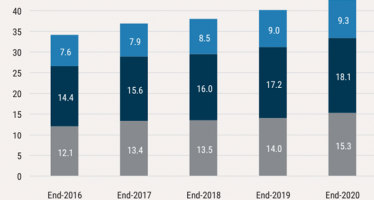ECB | European Central Bank: President’s Address at the 14th ECB and its Watchers Conference

Mario Draghi, President of the European Central Bank
Mario Draghi, President of the ECB, Frankfurt am Main, 15 June 2012
Ladies and Gentlemen,
It is a great pleasure to take part in this fourteenth edition of the ECB watchers conference – and the first I am attending as President of the European Central Bank.
As you are all aware, the ECB has the crucial role of providing liquidity to sound bank counterparties in return for adequate collateral. This is what we have done throughout the crisis, faithful to our mandate of maintaining price stability over the medium term – and this is what we will continue to do. The Eurosystem will continue to supply liquidity to solvent banks where needed.
In normal times, “adequate liquidity” may be defined as a volume of refinancing in line with the need for banks to meet the obligatory reserve requirements and the financing of other autonomous factors.
In times of increased financial instability, “adequate liquidity” indicates a volume of central bank money that also counteracts a temporary inability of banks to refinance in the market, which could lead to systemic consequences for the banking sector as a whole.
In my introductory remarks this morning, I will talk in a little more detail about the ECB’s monetary policy. I will also discuss Europe’s agenda for growth and issues relating to a longer-term vision of our economic and monetary union.
1. Considerations on monetary policy
Let me start with monetary policy.
There are two features I would like to highlight.
The first relates to the effectiveness of the three-year long-term refinancing operations (LTROs) that we launched a few months ago.
 As you will recall, these operations were introduced in an environment where money market spreads had surged, liquidity had dried up and banks’ access to market-based funding had eroded rapidly.
As you will recall, these operations were introduced in an environment where money market spreads had surged, liquidity had dried up and banks’ access to market-based funding had eroded rapidly.
The uncertainty about market-based funding for banks – especially medium-term funding – was perhaps the most critical issue in that environment. It truly threatened to undermine bank lending and created pressures for a broad-based deleveraging.
A resulting credit crunch would have severely aggravated the slowdown in economic activity, hurt employment and given rise to acute downside risks to price stability.
We must always remember that over two thirds of external financing of firms comes from banks. This ratio is even higher for small and medium-sized enterprises, which account for about three quarters of corporate employment in the euro area.
It is against this background that we decided to launch the three-year LTROs.
Their objectives have been broadly met.
The April bank lending survey points to a marked decline in the net tightening of credit standards and a general improvement in banks’ funding conditions. This evidence is supported by a range of market and other indicators. Overall, it confirms that supply side constraints on bank credit have been removed. This has been a very important result.
The full supportive impact of the three-year LTROs needs time to unfold, so it is too early to draw firm conclusions about the behaviour of a single variable – namely, bank credit to the private economy – that is influenced by a multitude of factors. In the current environment of very weak credit demand and heightened risk aversion, a rebound in the volume of credit will be particularly slow.
Yet granular balance sheet data indicate that in February and March, banks domiciled in stressed constituencies could interrupt and partly reverse the sustained decline in loans over the previous months. Indeed, smaller banks in some of those countries could increase their supply of loans.
Inflation expectations remain well anchored and there is no inflation risk in any euro area country. Financial market-based inflation expectations over a ten-year horizon are consistent with our definition of medium-term price stability. And should risks to price stability emerge, the Eurosystem has sufficient tools at its disposal to absorb excess liquidity.
The second point I would like to highlight as a way of understanding the ECB’s current conduct of monetary policy is heterogeneity. The situation regarding economic growth is quite different across the euro area.
This is not the first time; we had clearly diverging cycles ten years ago. At that time, growth in Germany was very low and growth in other countries was buoyant. This is part of a normal degree of cyclical heterogeneity that we observe in very large continental economies. It is very similar to what we observe in terms of cyclical heterogeneity within the United States.
What is new in the current episode is the parallel fragmentation of financial markets. This first concerns the interbank market, which works almost exclusively on a national, collateralised and very short-term basis. It is also true for broader capital markets and private capital flows, where home bias is rising.
The prime reason for the current home bias is general risk aversion. In addition, we are very attentive in monitoring whether regulatory initiatives – including anticipation of future liquidity ratios – or initiatives from national supervisors are affecting this market, especially across borders.
We have partly responded to the fact of increased heterogeneity by allowing some national central banks to enlarge the collateral pool. This was essential to ensure sufficient outreach to the real economy in their constituencies in a context of significant heterogeneity. They could accept more direct credit claims, particularly to support credit to the small and medium-sized enterprises that are so important for investment and employment.
This collateral enlargement was crucial for addressing a situation of liquidity abundance in some countries and liquidity scarcity in others. The enlargement has taken place with prudence and its risk management framework is overseen by the Governing Council.
While the process will take time, the restoration of adequate credit flows and the renewed functioning of the interbank market remain our firm objectives.
2. Europe’s growth agenda
Let me now turn to the European growth agenda.
Strengthening the growth potential of our economies is crucial.
We have a whole range of pending reforms at the national level: the liberalisation of product markets; the removal of bureaucratic impediments to entrepreneurial activity; greater labour market flexibility, which facilitates the re-entry of the unemployed into the job market; and a growth-friendly composition of fiscal adjustment. Let me elaborate a little.
Product market regulations can be streamlined so as to foster competition, particularly in sheltered professions and the services sector. Extensive administrative reforms should facilitate the start-up of new firms. Moreover, judicial systems can be adjusted so as to resolve and avoid court backlogs, which hamper the conduct of business activities. Once a critical mass for such reforms is achieved, they will considerably strengthen economic dynamism, innovation and employment.
These efforts should be complemented by active labour market policies, targeted at the low-skilled, the elderly and young unemployed people. This would facilitate re-entry into productive activities for those who typically face the most difficult starting position. It would also foster social cohesion despite the burden of economic adjustment facing our economies.
Second, important reforms are pending at the EU level, with the implementation of the Services Directive being a very important initiative to facilitate cross-border trade in services. By reducing the market power of producers, these reforms will put downward pressure on prices and upward pressure on productivity.
Third, I believe that we should oversee national reforms to promote growth in a way that is a parallel to the way in which we oversee fiscal policies. Here we might draw inspiration from the fiscal compact and the idea of avoiding unsustainable policies in the first place and providing incentives for positive reform. In a single currency area, national reforms that affect growth potential and competitiveness are just as important as fiscal policies because they are equally essential for economic sustainability.
Fourth, many items that are considered at the national level could be considered at the EU level. For example, measures to foster labour mobility could be implemented, inter alia by facilitating the cross-border portability of pension rights. European funds could be reallocated to areas most conducive to long-term growth and durable employment opportunities. And the capacity of the European Investment Bank to finance infrastructure projects could be strengthened.
As you can see, there is a long-standing agenda on growth. It is time to implement it with determination and confidence about its longer-term benefits.
Collectively we can compete more effectively in the global economy. Collectively we can better support growth and job creation. And collectively we can preserve our common European values of fairness, social cohesion and social progress.
3. Considerations regarding the longer-term vision for economic and monetary union
Let me turn to the broader question about the evolution of the euro area towards a genuine economic union – one that is commensurate with our monetary union.
As you know, I am in close contact with Presidents Herman Van Rompuy, José-Manuel Barroso and Jean-Claude Juncker to reflect on elements of a longer-term vision for our economic and monetary union. Ultimately, such a vision can be the basis for a process where objectives, progress, conditions and deadlines are specified; and where credibility is substantiated by action in the short run that is in line with long-term objectives.
Since this is a joint effort and our work is still in progress, I cannot provide specifics about this matter as yet.
But I can tell you that my reflections are founded on the central aim of securing stability and sustained prosperity for the euro area.
Price stability will remain a cornerstone of economic and monetary union, as it has been since the beginning. But in order to preserve broader economic stability, we need strengthened foundations in the fields of financial, fiscal and structural policy-making.
The strengthened foundations should secure the past achievements of integration. They should improve the management of the euro area economy. And they should bring economic and monetary union closer to the hearts and minds of Europe’s citizens, whose ownership of our collective project of integration has been shaken by the crisis.
A key issue in this context is sovereignty.
In processes of economic integration, we often speak about giving up sovereignty. Yet integration is far from being equivalent to giving up sovereignty. There are many cases in which integration implies a “sharing” or “pooling” of sovereignty. And there are some cases where integration actually leads to more sovereignty and at a higher level.
For example, some smaller euro area countries actually regained sovereignty with the euro by regaining influence over monetary policy at a higher level.
Something similar may hold for countries joining the EU, when they can participate in the shaping of the single market rules rather than having to adjust to them. In a globalised economy, the dwindling of individual influence may actually be reversed through integration.
Of course, this is only true if countries and their citizens are involved in joint decision-making. The degree of participation is therefore much more important than the level of policy assignment to determine whether sovereignty is lost, shared or actually gained.
In the case of Europe, more and more decisions have been elevated to a supranational level because they could only be taken efficiently and effectively by accounting for interlinkages and spillovers. But at some point, when supranational institutions and processes continually gain influence, the need for greater political legitimacy becomes more and more pressing.
In some cases therefore, the first issue to consider with any possible further transfer of competencies would be the transfer of legitimacy through political accountability. If legitimacy is fully ensured at all levels, the policy assignment question can be answered on grounds of policy optimality.
Conclusion
Let me conclude.
As half a decade of crisis has forcefully demonstrated, macroeconomic and financial imbalances entail considerable challenges for the smooth functioning of our economic and monetary union.
Despite these challenges, our monetary policy framework, which is firmly anchored in central bank independence and a clear focus on price stability, has provided a robust basis for the ECB to deliver on its mandate. By preserving an unambiguous commitment to price stability, the ECB has made its best contribution to mitigating the fallout from the crisis. This commitment will continue to guide our policy in the time to come.
Thank you for your attention.
Source: http://www.ecb.europa.eu
You may have an interest in also reading…
Otaviano Canuto, World Bank: Making Returns on Knowledge – How Innovation Can Flow from Globalisation
The April issue of the International Monetary Fund’s World Economic Outlook (WEO) included a chapter on how globalisation has helped
World Bank Continues Support to Improve Vietnam’s Competitiveness with US$250 Million Credit
The World Bank’s Board of Executive Directors today approved a US$250 million credit to the Government of Vietnam for the
China’s Renminbi Needs Convertibility to Internationalise
On July 21, the Official Monetary and Financial Institutions Forum (OMFIF) published its eighth annual report on Global Public Investors



















































































